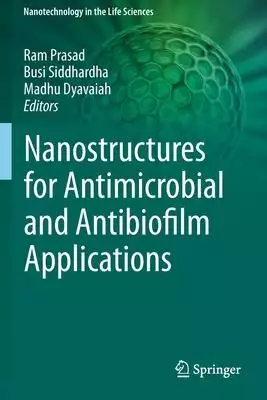Immunocompromised的問題,透過圖書和論文來找解法和答案更準確安心。 我們找到下列問答集和懶人包總整理
Immunocompromised的問題,我們搜遍了碩博士論文和台灣出版的書籍,推薦寫的 The Fungal Cell Wall: An Armour and a Weapon for Human Fungal Pathogens 和的 Nanostructures for Antimicrobial and Antibiofilm Applications都 可以從中找到所需的評價。
這兩本書分別來自 和所出版 。
國立高雄師範大學 生物科技系 廖麗貞、卜樂妙所指導 薛瑞珍的 台灣地區供水系統中退伍軍人菌血清型態調查 (2021),提出Immunocompromised關鍵因素是什麼,來自於退伍軍人症(LD)、退伍軍人菌屬、嗜肺性退伍軍人菌、血清型。
而第二篇論文高雄醫學大學 醫學檢驗生物技術學系碩士班 蔡季君、柯良胤所指導 徐妙禎的 初探新冠疫苗對不同宿主的免疫反應 (2021),提出因為有 新冠疫苗、愛滋病毒感染者、免疫力不全的重點而找出了 Immunocompromised的解答。
The Fungal Cell Wall: An Armour and a Weapon for Human Fungal Pathogens

為了解決Immunocompromised 的問題,作者 這樣論述:
JP Latgé has been the Head of the Aspergillus Unit at Institut Pasteur in Paris for the last 20 years and is now Professor at Institute of Molecular Biology and Technology, Foundation for Research and Technology-Hellas (FORTH), Heraklion, Crete, Greece. His research career has been focused on the st
udy of the biology of the human opportunistic fungal pathogen Aspergillus fumigatus through genetic, biochemical and immunological approaches. More precisely, studies are concentrated on the biosynthesis of the cell wall and associated extracellular matrix and the role of the components of these fun
gal structures during the fungal development in the immunocompetent and immunocompromised host. He has authored > 300 publications indexed in Pub Med, he is expert for several French and international grant review panels including ERC and has been the recipient of honors and key note speaker in mult
iple events in the Medical Mycology and Glycobiology fields.
Immunocompromised進入發燒排行的影片
台灣地區供水系統中退伍軍人菌血清型態調查
為了解決Immunocompromised 的問題,作者薛瑞珍 這樣論述:
退伍軍人菌是一種在自然界中廣泛存在的細菌,可以在河流、湖泊和水庫等環境水源中找到,通常數量很少。退伍軍人菌從天然源頭進入構成人工水庫的場所(城鎮的水渠、單個建築物的供水系統等)。許多研究報告發現,退伍軍人菌的主要來源是大型建築物的飲用水系統包括醫院、療養院和旅館。退伍軍人菌是院內感染肺炎的常見病原菌,特別是出現在免疫功能低下的患者,其中嗜肺退伍軍人菌幾乎是所有確診病例的致病菌屬。退伍軍人症在臨床上仍有很大程度無法被完全診斷出來。本研究是2017~2020年在台灣經由環境監測採集水樣5,162件,將水樣250mL以標準程序檢測退伍軍人菌在供水系統管路中移生情況。乳膠凝集試驗和直接螢光抗體檢測退
伍軍人菌進行血清分型。嗜肺性退伍軍人菌的分離率為91.8% (404/440),嗜肺性退伍軍人菌第一血清型Lp1 為40.2% (177/440)、嗜肺性退伍軍人菌第六血清型Lp6 佔 24.3% (107/440),其次是嗜肺性退伍軍人菌第三血清型Lp3 (5.7%, 25/440)、嗜肺性退伍軍人菌第二血清型Lp2 (3.2%, 14/440)、嗜肺性退伍軍人菌第五血清型Lp5 (1.4%, 6/440) 和嗜肺性退伍軍人菌第七血清型 Lp7 (0.5% , 2/441)。非嗜肺性退伍軍人菌屬占 8.2% (36/440)。依據檢體來源,在供水系統中嗜肺性退伍軍人菌第一血清型Lp1 分離
率為 39.4% (134/340),非嗜肺性退伍軍人菌第一血清型分離率為 60.6% (206/340)。冷卻水塔中嗜肺性退伍軍人菌第一血清型Lp1 的分離率為 67.2% (43/66),非嗜肺性退伍軍人菌第一血清型的隔離率為 48.8%(21/66)。對於嗜肺性退伍軍人菌第一血清型以外的退伍軍人病,除了嗜肺性退伍軍人菌第一血清型尿抗原檢測外,還應建立核酸檢測和微生物培養的實驗室診斷能力,以檢測退伍軍人症。顯然地開發更具廣譜的退伍軍人菌快速診斷試劑是當前迫切需求的目標。本項研究提供退伍軍人菌的持續監測計劃有利的基礎數據,期許在台灣退伍軍人症的預防和流行病學調查上做出更有意義的貢獻。
Nanostructures for Antimicrobial and Antibiofilm Applications

為了解決Immunocompromised 的問題,作者 這樣論述:
Ram Prasad, Ph.D. is associated with Amity Institute of Microbial Technology, Amity University, Uttar Pradesh, India since 2005. His research interest includes applied microbiology, plant-microbe-interactions, sustainable agriculture and nanobiotechnology. Dr. Prasad has more than hundred publicatio
ns to his credit, including research papers, review articles & book chapters and five patents issued or pending, and edited or authored several books. Dr. Prasad has twelve years of teaching experience and has been awarded the Young Scientist Award (2007) & Prof. J.S. Datta Munshi Gold Medal (2009)
by the International Society for Ecological Communications; FSAB fellowship (2010) by the Society for Applied Biotechnology; the American Cancer Society UICC International Fellowship for Beginning Investigators, USA (2014); Outstanding Scientist Award (2015) in the field of Microbiology by Venus Int
ernational Foundation; BRICPL Science Investigator Award (ICAABT-2017) and Research Excellence Award (2018). He has been serving as editorial board members: Frontiers in Microbiology, Frontiers in Nutrition, Academia Journal of Biotechnology including Series editor of Nanotechnology in the Life Scie
nces, Springer Nature, USA. Previously, Dr. Prasad served as Visiting Assistant Professor, Whiting School of Engineering, Department of Mechanical Engineering at Johns Hopkins University, USA and Research Associate Professor at School of Environmental Science and Engineering, Sun Yat-sen University,
Guangzhou, China.Busi Siddhardha, Ph.D. is a full-time Assistant Professor at the Department of Microbiology, Pondicherry University (a central university) Puducherry, India from 2011. Prior to joining the Pondicherry University, he was teaching at the Gurukul Kangri University, Haridwar. In brief,
he has got more than 12 years of research and 7 years of teaching experience at the university level. Currently, there are five Ph.D. students under his guidance. He has published more than 60 research articles/book chapters in the leading national and international journals. Dr. Siddhardha has suc
cessfully completed two research projects on "quorum sensing attenuation and antibiofilm activity of natural products" funded by DST-SERB and UGC, India. Currently, he is a principle investigator of a project on "attenuation of quorum sensing and biofilm mediated virulence of Pseudomonas aeruginosa
by selected phytochemicals and understanding the mechanism of action" funded by DST-SERB (2018-2021). His current areas of research interests include antimicrobial drug discovery, nanobiotechnology, antivirulence therapy targeting bacterial quorum sensing and biofilms, and antimicrobial photodynamic
therapy. He pursued his Ph.D. in Biology Division from CSIR-IICT, Hyderabad, India. He has been awarded Junior Research Fellowship by Council for Scientific and Industrial Research (CSIR), India in the year 2005. He is editorial board member of several reputed journals. He is a member of many natio
nal and international scientific societies. Madhu Dyavaiah, Ph.D., is an Assistant Professor, in the Department of Biochemistry and Molecular Biology; Pondicherry University, Pondicherry. He has served as a Research Scientist in the Gen’NY’sis Center for Excellence in Cancer Genomic, University at A
lbany, USA (2006-2012), Postdoctoral fellow at Wadsworth Center, New York Dept. of Health, USA (2003-2006) and IISc. Bangalore, India (2002-2003). His research interest includes, Molecular Pathogenesis, DNA damage response, tRNA modification and translation regulation and aging biology. He has resea
rch experience in working with microbial pathogens includes, Cryptococcus, Candida and Fusarium spaces. Currently, he is working with different model systems such as S. cerevisiae and mice model to study the effect of natural compounds on age-related diseases including neurodegenerative diseases and
cancer. He has been conferred with various prestigious awards in USA and India. He has served as referee for a number of International journals, including Food Sciences and Toxicology Research. He has more than 15 years of research and 8 years of teaching experience in Genomics, Proteomics, Molecul
ar Biology, Clinical Biochemistry Biology and Drug Discovery. He has also published more than 20 research articles and a review in the peer-reviewed international journal, and authored three book chapters, which includes a chapter, "Yeasts: Candida and Cryptococcus" in the book entitled "Bacterial a
nd Mycotic Infections in Immunocompromised Hosts: Clinical and Microbiological Aspects" He is a member of many scientific societies and organizations.
初探新冠疫苗對不同宿主的免疫反應
為了解決Immunocompromised 的問題,作者徐妙禎 這樣論述:
新冠肺炎疫情自2019年底在中國武漢發現迄今已超過2年,雖已經過2年但疫情仍不見好轉,歐美地區國家也從一開始透過染疫達成群體免疫的政策改為接種疫苗產生免疫力。在現今鼓勵民眾施打疫苗的政策下,與擁有完整免疫系統的健康人相比,免疫力不全的人施打疫苗的敏感性或不確定性更大。免疫力不全的患者是感染嚴重特殊傳染性肺炎(COVID-19)重症的高風險族群,也被視為優先接種疫苗的族群,由於上述疾病族群自身免疫系統不佳,容易有施打疫苗後因為免疫力太低反而被感染COVID-19或者施打完疫苗後效果降低的問題。現今通過世界衛生組織緊急授權的疫苗被認為對大眾的使用是安全且有效的,但大部分的疫苗臨床3期試驗皆排除
了免疫力不全的族群。因此本篇研究欲探討免疫力不全族群施打新冠疫苗後其體內抗體濃度與一般人之差異、並分析差異之原因。 本研究取得人體試驗委員會核准,自2021年10月至2022年3月,招募年滿20-90歲並完整接種兩劑疫苗之受試者,共計納入204位受試者(174位健康人和30位免疫不全者)進行SARS-COV-2 IgG抗體檢測及施打疫苗後不良反應問卷調查。 研究結果顯示,施打兩劑疫苗後的血清轉化率為100%(204/204),且無論是施打哪一種兩劑新冠疫苗之組合,在健康人與免疫不全族群中抗體濃度沒有顯著差異,施打疫苗後的不良反應皆屬輕微副作用,沒有發生嚴重不良反應。在現今Omicron變異株快
速傳播下,疫苗施打極為重要,能有效地產生抗體產生保護力及降低副作用,且與健康人沒有重大差異下,對於免疫力不全的人來說可以有限度的降低疫苗施打的疑慮及猶豫,提高接種疫苗意願。